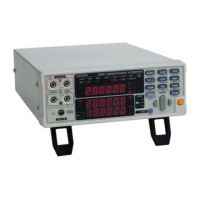8.4 Communication Methods
104
Compound
Command
Header Omission
When several commands having a common header are combined to
form a compound command (e.g., :CALCulate: LIMit:UPPer and
:CALCulate:LIMit:LOWer), if they are written together in
sequence, the common portion (here, :CALCulate:LIMit) can be
omitted after its initial occurrence.
This common portion is called the "current path" (analogous to the
path concept in computer file storage), and until it is cleared, the
interpretation of subsequent commands presumes that they share the
same common portion.
This usage of the current path is shown in the following example:
Full expression
:CALCulate:LIMit:UPPer 110000;:CALCulate:LIMit:LOWer 90000
Compacted expression
:CALCulate:LIMit:UPPer 110000;LOWer 90000
The current path is cleared when the power is turned on, when reset
by key input, by a colon ":" at the start of a command, and when a
message terminator is detected.
Standard command messages can be executed regardless of the
current path.
They have no effect upon the current path.
A colon ":" is not required at the start of the header of a Simple or
Compound command. However, to avoid confusion with abbreviated
forms and operating mistakes, we recommend always placing a colon
at the start of a header.
In this instrument, the current path is as follows
(for both GP-IB and RS-232C):
:CALCulate:LIMit:
This portion becomes the current path, and can be omitted from
the messages immediately following.

